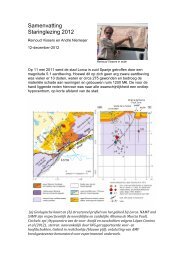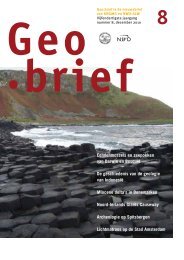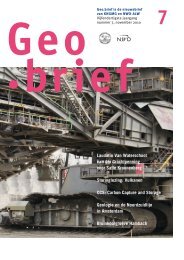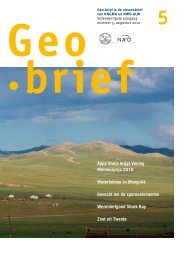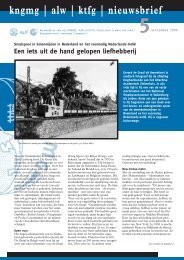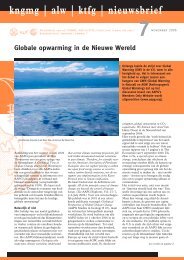Geobrief 2 - kngmg
Geobrief 2 - kngmg
Geobrief 2 - kngmg
You also want an ePaper? Increase the reach of your titles
YUMPU automatically turns print PDFs into web optimized ePapers that Google loves.
Water ice is one of the most abundant<br />
materials in our solar system. In earth<br />
and planetary science, ice can be seen<br />
as a solid polycrystalline aggregate. With<br />
varying pressure and temperature, ice can<br />
form at least 15 different crystalline forms.<br />
In our solar system, for instance within the<br />
icy moons of our planets, pressures can<br />
reach several GPa and temperatures as low<br />
as 233°C can exist. Under these extreme<br />
conditions ice phases uncommon on Earth<br />
can occur. The icy surfaces and inferred<br />
internal structures of icy planets and<br />
moons show a remarkable diversity.<br />
They form an important basis for comparative<br />
planetary research.<br />
Ice rheology and the dynamics<br />
of icy moons<br />
The flow behaviour of planetary ices<br />
strongly influences the thermal evolution<br />
and the tectonic history of icy moons. For<br />
icy moons like the satellites that revolve<br />
around Jupiter, it is assumed that beneath<br />
the ice crust, a subsurface ocean may<br />
exist. In particular Ganymede and Europa<br />
are believed to be good examples of satellites<br />
with subsurface oceans and a strong<br />
influence of ice rheology on planetary<br />
dynamics. The thickness of the presumed<br />
subsurface ocean is an important variable<br />
influencing the flow of ice on Europa,<br />
as has been shown by modelling studies<br />
performed at the TU Delft (Van Barneveld,<br />
Vermeersen). Modelling though is difficult<br />
because of uncertainties with respect to<br />
the thermal state of the icy satellites and<br />
incomplete understanding of the rheology<br />
of ice. Regarding the latter, the uncertainties<br />
in particular concern the possible role<br />
of grain (crystal) size controlling ice flow.<br />
Shedding some light on this is the main<br />
focus of my project. Extensive work on<br />
solid state flow of ceramics, metals and<br />
rocks has already shown that it is essential<br />
to have a quantitative understanding of<br />
grain size evolution during deformation,<br />
if laboratory derived rheological laws are to<br />
be reliably extrapolated to natural conditions.<br />
Hence, studying grain size evolution<br />
in deforming ice appears a logical step.<br />
The hypothesis<br />
Ice has already been deformed in the<br />
laboratory under a range of conditions,<br />
both from a glaciological and a geological<br />
perspective. This has resulted in the calibration<br />
of distinct socalled flow regimes.<br />
Two broad regimes can be distinguished;<br />
one regime in which ice flow is fully independent<br />
of the size of the grains (grainsizeinsensitive<br />
/ GSIcreep), and one<br />
regime in which the size of the grains does<br />
play an important role (grainsizesensitive<br />
/ GSScreep). In GSIcreep, defects within<br />
the crystal lattice (socalled dislocations)<br />
Internal structure of Ganymede. | Bron: Ganymedes: http://www.homepages.ucl.ac.uk/~ucfbanf/research/<br />
water_ice.htm<br />
play an important role in controlling de <br />
formation, while in GSScreep sliding of<br />
grains with respect to each other, accommodated<br />
by diffusion processes, is important.<br />
A socalled deformation mechanism<br />
map can be used to illustrate under what<br />
conditions GSI or GSScreep will occur<br />
(see figure on next page).<br />
If now during deformation the grain size<br />
changes, the flow behaviour of the material<br />
Ice phase diagram. | Bron: http://faculty.gg.uwyo.<br />
edu/neil/glaciology/photos/ices_phases2.jpg<br />
might change from GSI to GSSdominated<br />
or the other way around. Central in my<br />
project is the hypothesis that the fundamental<br />
processes resulting in reduction<br />
of grain size will, at some point in the<br />
deformation history, become counteracted<br />
by processes causing grain growth. Subsequently,<br />
grain growth will be counteracted<br />
by reduction processes when the grain size<br />
is large again. The flowing material thus<br />
can be expected to end up in the boundary<br />
zone between the GSS and GSIcreep<br />
fields. If this holds for ice, it will give good<br />
constraints on the prediction of rheology<br />
at conditions pertaining to icy moons.<br />
The approach<br />
Assuming that a balance between grain<br />
size reduction and grain growth indeed<br />
develops, an important question is when<br />
that would happen. One might expect that<br />
it takes a substantial amount of deformation<br />
(‘strain’) before a material with progressively<br />
reducing grain size reaches the<br />
point of counteraction by grain growth, or<br />
conversely, a material with growing grains<br />
becoming affected by grain size reduction.<br />
Finding out whether or not a steadystate<br />
balance between GSI and GSScreep<br />
maart 2011 Geo.brief 13



